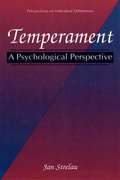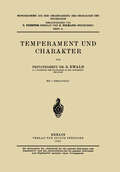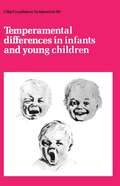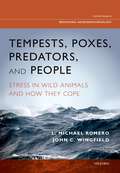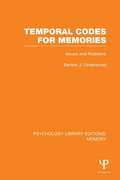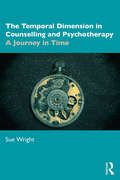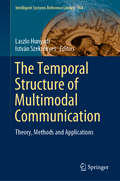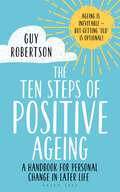- Table View
- List View
Temperament: Theory And Practice (Basic Principles Into Practice Ser. #Vol. 12)
by Stella Chess Alexander ThomasFirst published in 1997. Routledge is an imprint of Taylor & Francis, an informa company.
Temperament: Infancy through Adolescence The Fullerton Longitudinal Study (Longitudinal Research in the Social and Behavioral Sciences: An Interdisciplinary Series)
by Diana Wright Guerin Allen W. Gottfried Pamella H. Oliver Craig W. ThomasThe Fullerton Longitudinal Study, launched in 1979, chronicled the development of over 100 children and their families from the children's first birthday through their high school completion using a cross-informant/cross-context methodology. In this volume, the developmental course and sequelae of children's temperament from age 1.5 years through high school completion are documented. It is an important resource for developmental researchers, clinicians, educators, and students.
Temperament: A Psychological Perspective (Perspectives on Individual Differences)
by Jan StrelauTemperament is the first monograph in 40 years to present theories and basic findings in the field of temperament from a broad international and interdisciplinary perspective. The text, based on the author's four decades of personal study and data collection, thoroughly explores the physiological, biochemical, and genetic bases of temperament - incorporating age-specific methods of assessment developed through child- and adult-oriented approaches. The 147 illustrations comprise tables of the most popular temperament inventories for both children and adults, and unique data tables illustrating the psychometric features of temperament inventories based on self-rating and rating by others.
Temperament and Children: Profiles of Individual Differences
by Roy P. Martin A. Michele Lease Helena R. SlobodskayaThe book presents an empirical model of commonly occurring individual differences in children that is derived from a large-scale research effort assessing parental and teacher perceptions of children in middle childhood. It examines eight characteristic behavioral traits, most of which have been widely shown to be present in infants, toddlers, and preschool-aged children. The book demonstrates the importance of considering profiles of these relatively stable individual differences for the educational, social, and emotional life of the child. It describes characteristic behaviors of children within each profile – emphasizing the assets and liabilities of each – and how they are perceived by their parents, teachers, and peers. Chapters explore issues related to the most developmentally effective management of children exhibiting each profile type.In addition, the book addresses a critical need in child development, parenting, and teaching to understand the wide range of individual differences observed every day in school-aged children. Not only does this volume underscore that commonly occurring differences can be understood as being normal and do not suggest a pathology, it also discusses implications of the model in diagnosing pathology. The book describes what is known about the stability of temperament behaviors and profiles across the lifespan as well as the origins of these behaviors.Key topics addressed include:Nurturing development of well-adjusted children.Causes of individual differences in children’s behavior.Temperamental tendencies and profiles of children.Diagnosing psychopathology in children.This book is a must-have resource for researchers, professors, and graduate students as well as clinicians and related professionals in developmental, clinical child and school psychology, social work, public health, pediatrics, family studies, educational psychology and counseling, and all other interrelated disciplines.
Temperament und Charakter (Monographien aus dem Gesamtgebiete der Neurologie und Psychiatrie #41)
by G. EwaldDieser Buchtitel ist Teil des Digitalisierungsprojekts Springer Book Archives mit Publikationen, die seit den Anfängen des Verlags von 1842 erschienen sind. Der Verlag stellt mit diesem Archiv Quellen für die historische wie auch die disziplingeschichtliche Forschung zur Verfügung, die jeweils im historischen Kontext betrachtet werden müssen. Dieser Titel erschien in der Zeit vor 1945 und wird daher in seiner zeittypischen politisch-ideologischen Ausrichtung vom Verlag nicht beworben.
Temperament und Kinder: Profile der individuellen Unterschiede
by Roy P. Martin A. Michele Lease Helena R. SlobodskayaDas Buch stellt ein empirisches Modell der häufig vorkommenden individuellen Unterschiede bei Kindern vor, das aus einer groß angelegten Forschungsarbeit abgeleitet wurde, bei der die Wahrnehmungen von Eltern und Lehrern von Kindern in der mittleren Kindheit untersucht wurden. Es werden acht charakteristische Verhaltensmerkmale untersucht, von denen die meisten nachweislich bei Säuglingen, Kleinkindern und Kindern im Vorschulalter vorhanden sind. Das Buch zeigt, wie wichtig die Berücksichtigung von Profilen dieser relativ stabilen individuellen Unterschiede für das pädagogische, soziale und emotionale Leben des Kindes ist. Es beschreibt charakteristische Verhaltensweisen von Kindern innerhalb jedes Profils - wobei die Vorzüge und Nachteile jedes Profils hervorgehoben werden - und wie sie von ihren Eltern, Lehrern und Gleichaltrigen wahrgenommen werden. In den Kapiteln werden Fragen im Zusammenhang mit dem entwicklungsmäßig effektivsten Umgang mit Kindern, die die einzelnen Profiltypen aufweisen, untersucht.Darüber hinaus befasst sich das Buch mit dem kritischen Bedürfnis in der kindlichen Entwicklung, der Elternschaft und dem Unterricht, die große Bandbreite individueller Unterschiede zu verstehen, die täglich bei Kindern im Schulalter beobachtet werden. Dieser Band unterstreicht nicht nur, dass häufig auftretende Unterschiede als normal angesehenwerden können und nicht auf eine Pathologie hindeuten, sondern erörtert auch die Auswirkungen des Modells auf die Diagnose von Pathologien. Das Buch beschreibt, was über die Stabilität von Verhaltensweisen und Profilen des Temperaments über die gesamte Lebensspanne hinweg bekannt ist, sowie die Ursprünge dieser Verhaltensweisen. Zu den wichtigsten Themen gehören: Förderung der Entwicklung von Kindern, die sich gut entwickeln. Ursachen für individuelle Unterschiede im Verhalten von Kindern. Temperamentvolle Tendenzen und Profile von Kindern. Diagnose von Psychopathologie bei Kindern. Dieses Buch ist ein unverzichtbares Hilfsmittel für Forscher, Professoren und Studenten sowie für Kliniker und verwandte Berufsgruppen in den Bereichen Entwicklungs-, klinische Kinder- und Schulpsychologie, Sozialarbeit, öffentliches Gesundheitswesen, Pädiatrie, Familienstudien, pädagogische Psychologie und Beratung sowie allen anderen verwandten Disziplinen.
Temperamental Differences in Infants and Young Children (Novartis Foundation Symposia #89)
by Geralyn M. Collins Ruth PorterThe Novartis Foundation Series is a popular collection of the proceedings from Novartis Foundation Symposia, in which groups of leading scientists from a range of topics across biology, chemistry and medicine assembled to present papers and discuss results. The Novartis Foundation, originally known as the Ciba Foundation, is well known to scientists and clinicians around the world.
Tempests, Poxes, Predators, and People: Stress in Wild Animals and How They Cope (Oxford Series in Behavioral Neuroendocrinology)
by L.Michael Romero John C. WingfieldAlthough scientists have discovered many fundamental physiological and behavioral mechanisms that comprise the stress response, most of current knowledge is based on laboratory experiments using domesticated or captive animals. Scientists are only beginning, however, to understand how stress impacts wild animals - by studying the nature of the stressful stimuli that animals in their natural environments have adapted to for survival, and what the mechanisms that allow that survival might be. This book summarizes, for the first time, several decades of work on understanding stress in natural contexts. The aim is two-fold. The first goal of this work is to place modern stress research into an evolutionary context. The stress response clearly did not evolve to cause disease, so that studying how animals use the stress response to survive in the wild should provide insight into why mechanisms evolved the way that they did. The second goal is to provide predictions on how wild animals might cope with the Anthropocene, the current period of Earth's history characterized by the massive human remodeling of habitats on a global scale. Conservation of species will rely upon how wild animals use their stress response to successfully cope with human-created stressors.
Temporal Codes for Memories: Issues and Problems (Psychology Library Editions: Memory)
by Benton J. UnderwoodGiven two events, both of which are well remembered, can we specify which event occurred first? If so, how? For example, did Nixon resign, before or after Billie Jean King beat Bobby Riggs? Originally published in 1977, little was known about the accuracy of temporal codes for memories, and still less about the nature of the codes. This volume addresses the central question of the mechanisms by which order information is attached to memories. The results of sixteen previously unpublished experiments indicate the role of some independent variables on temporal coding in relatively short-term memory and in long-term memory. Several experiments, in which changes in proactive inhibition are used as an index of temporal differentiation, show that the nature of the words making up the lists is involved fundamentally in temporal coding. Other experiments demonstrate that in relatively short-term memory a subject cannot learn to improve his performance in estimating how far apart in time two events occurred. Still other experiments show that recency judgments for two events improve with practice, but the improvement is independent of the temporal separation. The context in which memories are established is shown to influence temporal codes only if an ordering metric is part of the context. The author advances several theoretical propositions to account for the various findings. In doing so he has given initial structuring for subsequent research to a neglected area. This volume will still be of significant interest to all those interested in learning and memory.
Temporal Codes for Memories: Issues and Problems (Psychology Library Editions: Memory)
by Benton J. UnderwoodGiven two events, both of which are well remembered, can we specify which event occurred first? If so, how? For example, did Nixon resign, before or after Billie Jean King beat Bobby Riggs? Originally published in 1977, little was known about the accuracy of temporal codes for memories, and still less about the nature of the codes. This volume addresses the central question of the mechanisms by which order information is attached to memories. The results of sixteen previously unpublished experiments indicate the role of some independent variables on temporal coding in relatively short-term memory and in long-term memory. Several experiments, in which changes in proactive inhibition are used as an index of temporal differentiation, show that the nature of the words making up the lists is involved fundamentally in temporal coding. Other experiments demonstrate that in relatively short-term memory a subject cannot learn to improve his performance in estimating how far apart in time two events occurred. Still other experiments show that recency judgments for two events improve with practice, but the improvement is independent of the temporal separation. The context in which memories are established is shown to influence temporal codes only if an ordering metric is part of the context. The author advances several theoretical propositions to account for the various findings. In doing so he has given initial structuring for subsequent research to a neglected area. This volume will still be of significant interest to all those interested in learning and memory.
The Temporal Dimension in Counselling and Psychotherapy: A Journey in Time
by Sue WrightThe Temporal Dimension in Counselling and Psychotherapy looks at time as an intangible phenomenon that is culturally created, historically framed, but only individually understood. Examining our relationship to time as well as what it means in terms of our mortality, it integrates historical, cultural and psychotherapeutic perspectives to shine a light on our experience of time from our current identity to past trauma, both in the consulting room and beyond. Divided into three parts, the book explores those time-related issues that emerge in psychotherapy, it initially focuses on our existence as individuals in time, with chapters discussing how we develop a sense of self as a being-in-time, how our relationship to time is coloured by the world we live in today, and our attachment relationships and past traumas. In part two, the focus narrows to the consulting room itself; the practical aspects of the time-frame and how these can be managed. The third part of the book concerns the impact of trauma and other crises on our existence in time, as well as our experience of it. Exploring time-related issues as people navigate different stages in the life-cycle, as well as for people affected by illness, trauma and bereavement, this insightful and thought-provoking book will provide insights for counsellors and therapists about what time means both to themselves and their clients.
The Temporal Dimension in Counselling and Psychotherapy: A Journey in Time
by Sue WrightThe Temporal Dimension in Counselling and Psychotherapy looks at time as an intangible phenomenon that is culturally created, historically framed, but only individually understood. Examining our relationship to time as well as what it means in terms of our mortality, it integrates historical, cultural and psychotherapeutic perspectives to shine a light on our experience of time from our current identity to past trauma, both in the consulting room and beyond. Divided into three parts, the book explores those time-related issues that emerge in psychotherapy, it initially focuses on our existence as individuals in time, with chapters discussing how we develop a sense of self as a being-in-time, how our relationship to time is coloured by the world we live in today, and our attachment relationships and past traumas. In part two, the focus narrows to the consulting room itself; the practical aspects of the time-frame and how these can be managed. The third part of the book concerns the impact of trauma and other crises on our existence in time, as well as our experience of it. Exploring time-related issues as people navigate different stages in the life-cycle, as well as for people affected by illness, trauma and bereavement, this insightful and thought-provoking book will provide insights for counsellors and therapists about what time means both to themselves and their clients.
The Temporal Structure of Multimodal Communication: Theory, Methods and Applications (Intelligent Systems Reference Library #164)
by Laszlo Hunyadi István SzekrényesThe general focus of this book is on multimodal communication, which captures the temporal patterns of behavior in various dialogue settings. After an overview of current theoretical models of verbal and nonverbal communication cues, it presents studies on a range of related topics: paraverbal behavior patterns in the classroom setting; a proposed optimal methodology for conversational analysis; a study of time and mood at work; an experiment on the dynamics of multimodal interaction from the observer’s perspective; formal cues of uncertainty in conversation; how machines can know we understand them; and detecting topic changes using neural network techniques. A joint work bringing together psychologists, communication scientists, information scientists and linguists, the book will be of interest to those working on a wide range of applications from industry to home, and from health to security, with the main goals of revealing, embedding and implementing a rich spectrum of information on human behavior.
Temporality and Shame: Perspectives from Psychoanalysis and Philosophy (Philosophy and Psychoanalysis)
by Ladson Hinton Hessel WillemsenWinner of the 2018 American Board and Academy of Psychoanalysis (ABAPsa) prize for best Edited book Temporality has always been a central preoccupation of modern philosophy, and shame has been a major theme in contemporary psychoanalysis. To date, however, there has been little examination of the critical connection between these core experiences. Although they deeply implicate each other, no single book has focused upon their profound interrelationship. Temporality and Shame highlights the many dimensions of that reality. A core point of this book is that shame can be a teacher, and a crucial one, in evaluating our ethical and ontological position in the world. Granting the fact that shame can be toxic and terrible, we must remember that it is also what can orient us in the difficult task of reflection and consciousness. Shame enables us to become more fully present in the world and authentically engage in the flow of temporality and the richness of its syncopated dimensionality. Such a deeply honest ethos, embracing the jarring awareness of shame and the always-shifting temporalities of memory, can open us to a fuller presence in life. This is the basic vision of Temporality and Shame. The respective contributors discuss temporality and shame in relation to clinical and theoretical aspects of psychoanalysis, philosophy, anthropology, and genocide, as well as the question of evil, myth and archetype, history and critical studies, the ‘discipline of interiority’, and literary works. Temporality and Shame provides valuable insights and a rich and engaging variety of ideas. It will appeal to psychotherapists and psychoanalysts, philosophers and those interested in the basic philosophical grounds of experience, and anthropologists and people engaged in cultural studies and critical theory.
Temporality and Shame: Perspectives from Psychoanalysis and Philosophy (Philosophy and Psychoanalysis)
by Ladson Hinton Hessel WillemsenWinner of the 2018 American Board and Academy of Psychoanalysis (ABAPsa) prize for best Edited book Temporality has always been a central preoccupation of modern philosophy, and shame has been a major theme in contemporary psychoanalysis. To date, however, there has been little examination of the critical connection between these core experiences. Although they deeply implicate each other, no single book has focused upon their profound interrelationship. Temporality and Shame highlights the many dimensions of that reality. A core point of this book is that shame can be a teacher, and a crucial one, in evaluating our ethical and ontological position in the world. Granting the fact that shame can be toxic and terrible, we must remember that it is also what can orient us in the difficult task of reflection and consciousness. Shame enables us to become more fully present in the world and authentically engage in the flow of temporality and the richness of its syncopated dimensionality. Such a deeply honest ethos, embracing the jarring awareness of shame and the always-shifting temporalities of memory, can open us to a fuller presence in life. This is the basic vision of Temporality and Shame. The respective contributors discuss temporality and shame in relation to clinical and theoretical aspects of psychoanalysis, philosophy, anthropology, and genocide, as well as the question of evil, myth and archetype, history and critical studies, the ‘discipline of interiority’, and literary works. Temporality and Shame provides valuable insights and a rich and engaging variety of ideas. It will appeal to psychotherapists and psychoanalysts, philosophers and those interested in the basic philosophical grounds of experience, and anthropologists and people engaged in cultural studies and critical theory.
Temporality in Qualitative Inquiry: Theories, Methods and Practices
by Bryan C. Clift; Julie Gore; Stefanie Gustafsson; Sheree Bekker; Ioannis Costas Batlle; Jenny HatchardTemporality in Qualitative Inquiry explores the relationship between time and qualitative research and unpacks some of the conceptual, methodological, practical, and pragmatic areas of qualitative inquiry related to time and temporality. This book advances the understanding and re-evaluation of research practice by examining the passage of time, temporal feeling, and conceptualising of time/temporality in research practice with participants. It provides theoretical and practical insights into how to navigate the concepts of time and temporality in qualitative inquiry. With authors from across the globe and from an array of social sciences including cultural studies, education, health, management and business, psychology, sociology, and sport and exercise, the book explores theoretical, methodological, and practical discussions of time and temporality in order to unpack and elicit meaning and understanding. The editors champion the call for the existence of slow and quick qualitative methodologies and methods. As such, this book is suitable for graduate students and researchers interested in qualitative inquiry, and in disciplines such as education, health research, management, psychology, sociology, and communication studies. Chapter 2 of this book is freely available as a downloadable Open Access PDF under a Creative Commons Attribution-Non Commercial-No Derivatives 4.0 license at https://tandfbis.s3-us-west-2.amazonaws.com/rt-files/docs/Open+Access+Chapters/ISBN_oachapter2.pdf5
Temporality in Qualitative Inquiry: Theories, Methods and Practices
by Bryan C. Clift Julie Gore Stefanie Gustafsson Sheree Bekker Ioannis Costas Batlle Jenny HatchardTemporality in Qualitative Inquiry explores the relationship between time and qualitative research and unpacks some of the conceptual, methodological, practical, and pragmatic areas of qualitative inquiry related to time and temporality. This book advances the understanding and re-evaluation of research practice by examining the passage of time, temporal feeling, and conceptualising of time/temporality in research practice with participants. It provides theoretical and practical insights into how to navigate the concepts of time and temporality in qualitative inquiry. With authors from across the globe and from an array of social sciences including cultural studies, education, health, management and business, psychology, sociology, and sport and exercise, the book explores theoretical, methodological, and practical discussions of time and temporality in order to unpack and elicit meaning and understanding. The editors champion the call for the existence of slow and quick qualitative methodologies and methods. As such, this book is suitable for graduate students and researchers interested in qualitative inquiry, and in disciplines such as education, health research, management, psychology, sociology, and communication studies. Chapter 2 of this book is freely available as a downloadable Open Access PDF under a Creative Commons Attribution-Non Commercial-No Derivatives 4.0 license at https://tandfbis.s3-us-west-2.amazonaws.com/rt-files/docs/Open+Access+Chapters/ISBN_oachapter2.pdf5
Temporality, Shame, and the Problem of Evil in Jungian Psychology: An Exchange of Ideas
by Murray Stein Elena CaramazzaIn a unique epistolary style, authors Murray Stein and Elena Caramazza share their rich and reflective conversations surrounding the themes of temporality, shame, and evil through letters, essays, and email correspondence. Ignited by Wolfgang Pauli’s "The Piano Lesson," Stein and Caramazza study the function of temporality and consider the importance of shame and evil to this relationship. In this book Stein shows how Pauli, as a result of his contact with C.G. Jung and analytical psychology, embarked on a thought experiment to merge two currents of scientific thought: quantum physics and depth psychology. In his work of active imagination "The Piano Lesson," Pauli playfully brings together the former, which supplies a causal explanation of the mechanics of the material world, and the latter, which supplies an approach to meaning. The problem of how to merge the two currents in one language is presented in Pauli’s symbolic solution, piano music, which combines the black and white keys in a single harmony. This music symbolizes a unified theory that combines the explanations of causality and the meaning delivered by synchronicity. Presenting an original approach to synchronicity and dis-synchronicity, this interdisciplinary and innovative exchange concludes with a script written by Murray Stein, inspired by Pauli, as well as an afterword by influential Jungian scholars. This book will be a key reference for undergraduate and postgraduate courses and seminars in Jungian and post-Jungian studies, philosophy, psychoanalytic studies, psychology, and the social sciences.
Temporality, Shame, and the Problem of Evil in Jungian Psychology: An Exchange of Ideas
by Murray Stein Elena CaramazzaIn a unique epistolary style, authors Murray Stein and Elena Caramazza share their rich and reflective conversations surrounding the themes of temporality, shame, and evil through letters, essays, and email correspondence. Ignited by Wolfgang Pauli’s "The Piano Lesson," Stein and Caramazza study the function of temporality and consider the importance of shame and evil to this relationship. In this book Stein shows how Pauli, as a result of his contact with C.G. Jung and analytical psychology, embarked on a thought experiment to merge two currents of scientific thought: quantum physics and depth psychology. In his work of active imagination "The Piano Lesson," Pauli playfully brings together the former, which supplies a causal explanation of the mechanics of the material world, and the latter, which supplies an approach to meaning. The problem of how to merge the two currents in one language is presented in Pauli’s symbolic solution, piano music, which combines the black and white keys in a single harmony. This music symbolizes a unified theory that combines the explanations of causality and the meaning delivered by synchronicity. Presenting an original approach to synchronicity and dis-synchronicity, this interdisciplinary and innovative exchange concludes with a script written by Murray Stein, inspired by Pauli, as well as an afterword by influential Jungian scholars. This book will be a key reference for undergraduate and postgraduate courses and seminars in Jungian and post-Jungian studies, philosophy, psychoanalytic studies, psychology, and the social sciences.
Ten-Ager: What your daughter needs you to know about the transition from child to teen
by Madonna KingFrom the author of BEING 14 and FATHERS AND DAUGHTERS comes a book that shares what your daughter needs you to know about her shift from child to teenager - how she feels, what she thinks, what worries her and what you can do to help.Science tells us that the shift from childhood to teenager is happening earlier than ever before. Girls are starting puberty well before the age of thirteen. With heightened pressure from what they see in the media, in movies and on TV, girls are leaving childhood behind well before they hit their teens. This shift is an abrupt one and can come as a shock to parents. Not surprisingly, emotions can be heightened and relationships can be fraught. So many parents struggle to understand the pressures their daughters are under and how to deal with their emotional volatility. Journalist and social commentator Madonna King has an extraordinary ability to connect with experts, schools and the girls themselves to deliver the answers parents need and the communication their children want. This is an important book that shows that 10 is the new start of a girl's teenage years. It raises the issues our girls might not be talking about publicly, and guides their parents on how experts believe we should deal with it.
Ten Lectures on Psychotherapy and Spirituality
by Nathan Field Trudy Harvey Belinda SharpThis volume is a much-needed exploration of contemporary theories on psychotherapy and spirituality, moving away from the more traditional, non-spiritual aspects of psychoanalysis and psychotherapy. The book consists of a dialogue between the opposing sides; most of the papers have responses from the "other" side. This dialogue mirrors the early communication between Freud and Jung regarding spirituality, and opens up doors for continuing collaboration between psychoanalysis as a pure science and the spiritual and religious dimensions within. This inspiring collection of papers grew from the lectures held in 2002 at the London Centre for Psychotherapy. In the time of increased interest in more scientific schools of psychoanalysis such as neuropsycho-analysis, there is also a surge of interest in spirituality within psychoanalysis, as demonstrated by the great interest in these lectures.
Ten Lectures on Psychotherapy and Spirituality
by Nathan Field Trudy Harvey Belinda SharpThis volume is a much-needed exploration of contemporary theories on psychotherapy and spirituality, moving away from the more traditional, non-spiritual aspects of psychoanalysis and psychotherapy. The book consists of a dialogue between the opposing sides; most of the papers have responses from the "other" side. This dialogue mirrors the early communication between Freud and Jung regarding spirituality, and opens up doors for continuing collaboration between psychoanalysis as a pure science and the spiritual and religious dimensions within. This inspiring collection of papers grew from the lectures held in 2002 at the London Centre for Psychotherapy. In the time of increased interest in more scientific schools of psychoanalysis such as neuropsycho-analysis, there is also a surge of interest in spirituality within psychoanalysis, as demonstrated by the great interest in these lectures.
Ten Minutes for the Family: Systemic Interventions in Primary Care
by Eia Asen Dave Tomson Venetia Young Peter TomsonThe provision of suitable mental health care is one of the major tasks facing general practitioners and their teams. Family-oriented primary care has moved from doctor-controlled to patient-centred consultations, with a greater emphasis on collaboration. The systemic framework uniquely lends itself to this shift in emphasis, as it views the delivery of care in social rather than merely medical terms. There is now a strong evidence base for the efficacy of systemic approaches in managing many different types of mental health and relationship issues.This text is a practical guide for health professionals working in primary care who wish to improve their management of problem patients, problem families and problem situations. Step-by-step, it introduces both the theory and the practice of the family approach - from interviewing individual patients in routine consultations to conducting specific family crisis meetings. It includes many concrete suggestions for using simple family therapy techniques and encourages the clinician to think about cases constructively. Case histories and patient stories are used extensively to illustrate the techniques as well as boxed information to highlight key points.
Ten Minutes for the Family: Systemic Interventions in Primary Care
by Eia Asen Dave Tomson Venetia Young Peter TomsonThe provision of suitable mental health care is one of the major tasks facing general practitioners and their teams. Family-oriented primary care has moved from doctor-controlled to patient-centred consultations, with a greater emphasis on collaboration. The systemic framework uniquely lends itself to this shift in emphasis, as it views the delivery of care in social rather than merely medical terms. There is now a strong evidence base for the efficacy of systemic approaches in managing many different types of mental health and relationship issues.This text is a practical guide for health professionals working in primary care who wish to improve their management of problem patients, problem families and problem situations. Step-by-step, it introduces both the theory and the practice of the family approach - from interviewing individual patients in routine consultations to conducting specific family crisis meetings. It includes many concrete suggestions for using simple family therapy techniques and encourages the clinician to think about cases constructively. Case histories and patient stories are used extensively to illustrate the techniques as well as boxed information to highlight key points.
The Ten Steps of Positive Ageing: A handbook for personal change in later life
by Guy RobertsonAgeing is inevitable – but getting 'old' is optional! We can make a difference to our ageing process – just as we have to learn to grow up, so we have to learn to grow old.Here is a route map we can all follow to find a way through the changes we face as we age, and a toolkit of exercises to help us follow our chosen path and fulfil our potential. Ageing has got a really bad press but is it really as bad as much of the media make out? And is there anything we can do to make our later years happier and healthier? In this handbook Guy Robertson assembles the case for the defense and explodes some myths along the way. Getting older is not all bad! Indeed the reality is much more positive than many of us could imagine. Find here ten steps that anyone can take to improve the likelihood of living a happy and satisfying life in old age. Research shows that how we think about ageing can have a very significant impact on our health and wellbeing in later life. Concentrating on the psychological and emotional aspects of ageing, these clear practical exercises will empower the reader to engage in a programme of personal change.


